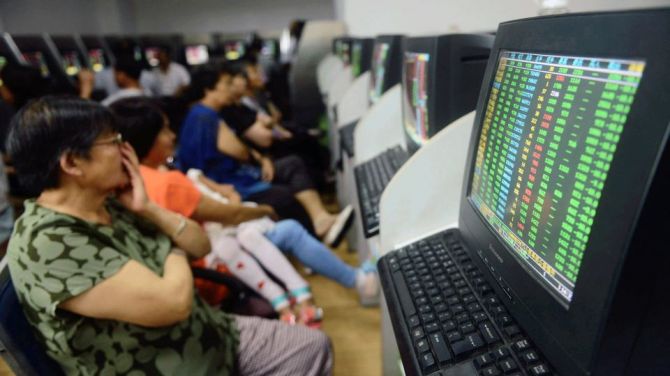The Chinese authorities have sought to position the yuan devaluation as a positive development; this reflects a transition to a more market-oriented process of exchange rate determination, says Subir Gokarn.

Recent developments in the Chinese financial sector have raised concerns globally about another looming crisis.
Fears about a currency war have been expressed and equity markets in both emerging and developed economies have plunged.
These views are in sharp contrast with the dominant Chinese narrative of just a few months ago.
At that point, China was positioning itself as the anchor of a new global financial and architecture, which posed a direct challenge to the Bretton Woods framework.
With the setting up of the New Development Bank and the Contingent Reserve Arrangement by the BRICS group, and the Asian Infrastructure Investment Bank with participation from over 50 countries, including some developed ones, China was well on its way to emerging as a competing pivot to the US and Europe.
Its Belt Road Initiative, which would eventually involve trade agreements with over 60 countries straddling both overland and maritime trade routes, would put it at the centre of a large and diverse plurilateral framework.
These are components of its blueprint to global economic dominance.
But, three months ago, financial turbulence began.
Beginning in June, the stock market declined by over 30 per cent in a month.
A massive rescue operation was initiated, combining liquidity infusions by the central bank and trading restrictions of all kinds, including suspension of new issuances.
The meltdown appeared to have been contained, but then, last week, there was another sharp decline of over 10 per cent.
This was preceded, of course, by a sudden devaluation of the Chinese yuan, which resulted in it falling in two stages by three per cent against the US dollar.
Seen individually, each of these developments may not have much significance. After all, equity and currency markets are relatively volatile. But, this is China we're talking about - a country whose ability to manage its economy has rarely been in doubt.
Seen as a whole, the financial turbulence paints a picture of the authorities losing control - reactivity rather than proactivity, not very credible communication and, as yet, no clear signs that things are stabilising.
The soaring vision of the Belt Road Initiative is strikingly at odds with the difficulties being experienced in controlling the financial turbulence.
The Chinese authorities have sought to position the yuan devaluation as a positive development. It reflects a transition to a more market-oriented process of exchange rate determination.
That this should be done in a situation in which it would necessarily depreciate is really only a coincidence of timing.
The fact that it has now stabilised gives some credence to this explanation.
After all, China's global leadership aspirations entail significant structural reforms in its capital markets, including full convertibility and a floating exchange rate.
This could be the beginning of the process.
The fact that the step was taken in a situation of export sluggishness, which would benefit from a depreciated currency was simply a matter of trying to kill two birds with one stone. However, two issues arise here.
One, the official explanation will not be tested until the currency dynamic reverses. It is the response, or more precisely, the lack of one, to an appreciating yuan that will tell us whether there is a new exchange rate framework in place.
If appreciation is not resisted, the world should be persuaded that this is indeed the case. Of course, we don't know when this is going to happen, which leads to the second issue.
This relates to the short term impacts of depreciated yuan.
There is both a direct dimension to this and an indirect one, in terms of the wider global context in which the depreciation took place.
The direct impact has already been seen in both analysis and market outcomes.
A large body of commentary on the depreciation sees it as a currency war - an attempt by China to boost its sagging exports, in turn to revive its slowing economy. Currencies of emerging economies have fallen sharply in the aftermath; many by far more than the yuan itself.
The implications of this asymmetry are another story, but for the moment, the fact that the currencies of competing countries have depreciated more do suggest the likelihood of further yuan movements, whether driven by market conditions or policy actions.
But, beyond the legitimate concerns about mercantilism, we should not lose sight of the larger picture.
Have Chinese exports been sluggish because of slackening global demand? In other words, is the global economy itself entering another period of fragility, notwithstanding the US recovery?
Signs of this abound, from the dismal growth numbers of many developed and emerging markets to the virtual free fall in commodity prices, particularly oil.
Our own export performance also reinforces the impression of global sluggishness.
If these concerns are valid, there are both global and domestic policy implications.
On the global side, the G-20 meeting of finance ministers and central bank heads is scheduled to meet in Ankara, Turkey early next month.
This issue should be on the top of their agenda, to prepare for the possibility of co-ordinated action.
On the domestic side, the imperative to reinforce our own growth drivers becomes that much more intense. Public investment in infrastructure, easing of doing business and lower interest rates are all part of this toolkit.
This is, of course, very much the standard policy narrative, but policymakers must appreciate the heightened urgency that developments in China and their global implications impart to it.
But, we must also be prepared to deal with the direct impact. A depreciated yuan accompanied by aggressive export marketing risks Indian markets being even more inundated with Chinese goods, more so by ones that are relatively labour intensive.
The WTO toolkit provides various instruments to deal with such situations - anti-dumping duties, countervailing duties and safeguard measures.
The government needs to use available instruments appropriately, balancing the interests of domestic consumers, producers and workers.
If a plan is not already in place, it should be the commerce ministry's priority to do so.
The more fundamental point which we need to consider is that transitions in world orders are never smooth, calm, or non-disruptive.
As China for global economic leadership, the adjustments it will necessarily make along the way are going to lead to more such situations.
The rest of the world needs to anticipate and prepare.
Subir Gokarn is director of research, Brookings India, and former deputy governor, Reserve Bank of India. The views are his own.












 © 2025
© 2025